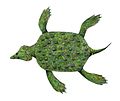Discovery and naming
Photographs from the excavation of the Chubutinectes type specimen
The Chubutinectes holotype specimen, MPEF-PV 5232, was discovered in 2009 within sediments of the La Colonia Formation on the Somún Curá plateau in Chubut Province, Argentina. The disarticulated specimen consists of cervical, pectoral, dorsal, sacral, and caudal vertebral centra and neural arches, various ribs, partial pectoral and pelvic girdles, fore- and hind-limb elements, and about 350 gastroliths. [1]
In 2023, O'Gorman and colleagues described Chubutinectes carmeloi as a new genus and species of elasmosaurid plesiosaur based on these fossil remains. The generic name, "Chubutinectes", combines a reference to the Argentinean province "Chubut", where the holotype was found, with the Greek word "nectes", meaning "swimmer". The specific name, "carmeloi", honors Carmelo Muñoz, the discoverer of the holotype. [1]
Paleoenvironment
Chubutinectes was discovered in layers of the La Colonia Formation, which dates to the upper Maastrichtian. Based on the presence of nanofossils of Micula spp., the rock layers are younger than around 67.3 million years old. The fellow elasmosaurid Kawanectes was also found in this formation, as well as the remains of indeterminate elasmosaurids and the polycotylid Sulcusuchus . [1] [4] Dinosaur fossils, including those of the abelisaurid theropods Carnotaurus and Koleken , titanosaurian sauropod Titanomachya , ankylosaurs, hadrosauroids, and somphospondylans, have also been found. [5] [6] [7] Other fossils animals include various species of mammals, turtles and snakes. [8] [9]
This page is based on this
Wikipedia article Text is available under the
CC BY-SA 4.0 license; additional terms may apply.
Images, videos and audio are available under their respective licenses.








